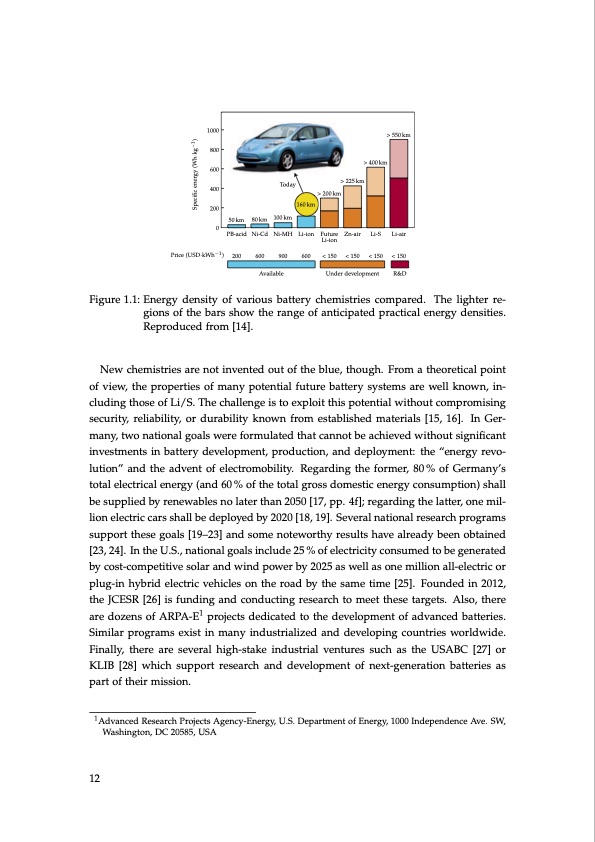
PDF Publication Title:
Text from PDF Page: 012
Today 160 km 50km 80km 100km > 550 km > 400 km > 225 km > 200 km 1000 800 600 400 200 0 Price (USD·kWh−1) PB-acid Ni-Cd Ni-MH Li-ion Future Zn-air Li-S Li-air Li-ion 200 600 900 600 < 150 < 150 < 150 < 150 Available Under development R&D Figure 1.1: Energy density of various battery chemistries compared. The lighter re- gions of the bars show the range of anticipated practical energy densities. Reproduced from [14]. New chemistries are not invented out of the blue, though. From a theoretical point of view, the properties of many potential future battery systems are well known, in- cluding those of Li/S. The challenge is to exploit this potential without compromising security, reliability, or durability known from established materials [15, 16]. In Ger- many, two national goals were formulated that cannot be achieved without significant investments in battery development, production, and deployment: the “energy revo- lution” and the advent of electromobility. Regarding the former, 80 % of Germany’s total electrical energy (and 60 % of the total gross domestic energy consumption) shall be supplied by renewables no later than 2050 [17, pp. 4f]; regarding the latter, one mil- lion electric cars shall be deployed by 2020 [18, 19]. Several national research programs support these goals [19–23] and some noteworthy results have already been obtained [23, 24]. In the U.S., national goals include 25 % of electricity consumed to be generated by cost-competitive solar and wind power by 2025 as well as one million all-electric or plug-in hybrid electric vehicles on the road by the same time [25]. Founded in 2012, the JCESR [26] is funding and conducting research to meet these targets. Also, there are dozens of ARPA-E1 projects dedicated to the development of advanced batteries. Similar programs exist in many industrialized and developing countries worldwide. Finally, there are several high-stake industrial ventures such as the USABC [27] or KLIB [28] which support research and development of next-generation batteries as part of their mission. 1Advanced Research Projects Agency-Energy, U.S. Department of Energy, 1000 Independence Ave. SW, Washington, DC 20585, USA 12 Specific energy (Wh·kg−1)PDF Image | Lithium-Sulfur Battery: Design, Characterization, and Physically-based Modeling

PDF Search Title:
Lithium-Sulfur Battery: Design, Characterization, and Physically-based ModelingOriginal File Name Searched:
Dissertation_David_N._Fronczek_The_Lithium_Sulfur_Battery.pdfDIY PDF Search: Google It | Yahoo | Bing
Sulfur Deposition on Carbon Nanofibers using Supercritical CO2 Sulfur Deposition on Carbon Nanofibers using Supercritical CO2. Gamma sulfur also known as mother of pearl sulfur and nacreous sulfur... More Info
CO2 Organic Rankine Cycle Experimenter Platform The supercritical CO2 phase change system is both a heat pump and organic rankine cycle which can be used for those purposes and as a supercritical extractor for advanced subcritical and supercritical extraction technology. Uses include producing nanoparticles, precious metal CO2 extraction, lithium battery recycling, and other applications... More Info
| CONTACT TEL: 608-238-6001 Email: greg@infinityturbine.com | RSS | AMP |